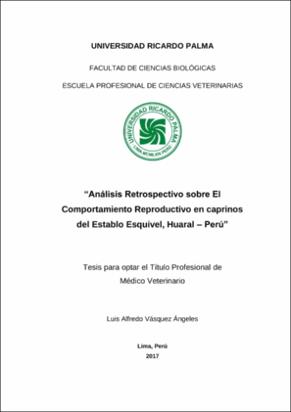| dc.description.abstract | La elaboración de productos alimentarios de origen animal, en este caso procedentes de la especie caprina, conforme ha pasado el tiempo, ha logrado tener una mayor aceptación de parte del hombre a nivel mundial, dado que los diversos productos que se pueden obtener entre ellos principalmente la carne y la leche, han originado que estos requieran de un uso razonable en cuanto a sus recursos y que faculten que los procesos productivos sean sustentables. El objetivo del presente estudio radica en analizar de forma retrospectiva el comportamiento reproductivo en caprinos del Establo Esquivel, ubicado en la provincia de Huaral del departamento de Lima, entre los periodos de los años del 2012 - 2013. Este estudio presenta un enfoque cualitativo, de tipo descriptivo, retrospectivo y no experimental. Entre los resultados obtenidos tenemos que para el año 2012, el intervalo de partos en promedio es de 341,27 días para el total de cabras registradas durante el periodo de estudio. Como resultado se obtuvo una fertilidad de 49,62%, además se observaron otros parámetros como prolificidad, fecundidad, mortalidad y tasa de abortos. Para el año 2013 el índice de intervalo entre partos en promedio fue de 284,1 días para el total de cabras registradas durante el periodo de estudio mientras que la fertilidad presentada fue de 89,2% tomando como base que se encontraban 112 ejemplares en celos durante todo el año, siendo los meses de mayor celo abril y mayo. A su vez, también se estudiaron la prolificidad, fecundidad y mortalidad. Para el año 2013 los partos se incrementaron de 66 a 138, teniendo un aumento de 109%, distribuidos en 74 partos sencillos, 56 dobles y 8 triples. Para un total de 194 crías nacidas, con 87 machos y 107 hembras, este año se permite evidenciar un aumento de nacimientos de crías hembras en comparación al año anterior. Este estudio muestra una aproximación de la situación en que se encuentra la producción caprina en Huaral. A partir de los datos obtenidos y que luego fueron analizados, se concluye que el
sistema de producción semi-intensivo en el establo Esquivel, permite tener índices favorables de producción.
The elaboration of food products of animal origin, in this case coming from the goat species, as time has passed, has managed to have a greater acceptance of the part of the man at world level, since the diverse products that can be obtained between them mainly meat and milk, have caused them to require a reasonable use of resources and to enable productive processes to be sustainable. The general objective of the present study is to analyze retrospectively the reproductive behavior of goats at the Barn Esquivel, located in the province of Huaral in the department of Lima, between the periods of the years of 2013. The present study presents a qualitative approach, Descriptive, retrospective and non-experimental. Among the results obtained, for the year 2012 under study, the average calving interval is 341.27 days for the total number of goats recorded during the study period. The fertility presented was 49.62%, in addition were observed other parameters such as prolificacy, fecundity, mortality and abortion rate. For the year 2013 the rate of calving intervals on average is 284.1 days for the total number of goats recorded during the study period while the fertility presented is 89.2% on the basis that there were 112 specimens in jealousy during all the year, being the months of greater zeal April and May. In turn, prolificity, fecundity and mortality were also studied. By 2013 births increased from 66 to 138, an increase of 109%, distributed in 74 single deliveries, 56 doubles and 8 triples. For a total of 194 newborns, with 87 males and 107 females, this year it is possible to show an increase in the births of young females compared to the previous year. This study shows an approximation of the situation in which caprine production is found in Huaral. From the data obtained and then analyzed, it is concluded that the semi-intensive production system in the Esquivel stable allows favorable production rates. | es_ES |

